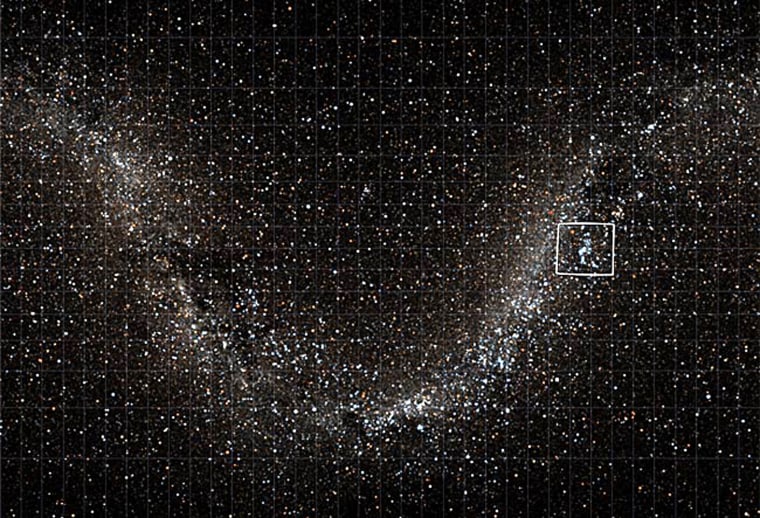A new search engine will soon turn your night sky images into powerful research data and identify the twinkling objects in them with just the click of a button.
The Astrometry.net database will hunt down and name celestial objects in any amateur photo, pinpoint the region of night sky that was photographed and use the image to expand a detailed database of the cosmos for use by scientists
David Hogg, an astronomer at New York University and leader of the project, showed off the still-in-development tool at the recent Astrophysics 2020 conference here at Johns Hopkins University's Space Telescope Science Institute.
"Any individual can take a picture of the sky, plug it in and learn what stars, galaxies or other objects are in their image," Hogg told SPACE.com. "It's fun for people to do this, but more importantly it'll provide data we need to make that image searchable and useful to scientists."
'Wiki' the sky
The project's driving force is astrometry: a branch of astronomy that relies on star positions to explain how they got there. Although stars may look stationary, they move in a slow "proper motion" from our Earthly vantage point.
"To understand the physics of a star cluster, you need to know the proper motions of stars in it," Hogg said, mentioning the Beehive Cluster in the constellation Cancer as an example. "When you run the clock back, you see the stars came out of some huge formation event."
The best way for astronomers to pin down the celestial motions—as well as keep tabs on the latest supernovae—is to take many images over time, Hogg explained. Problem is, monitoring the sky tedious and expensive.
Meanwhile, armies of amateurs scour the sky every minute of every day around the world. But most don't tag their images with "meta-data" scientists need, such as the exact time the photo was taken and location of the photographer on Earth at the time.
Hogg wants to change that.
"Amateurs with first-class equipment could really revolutionize how we think about doing this kind of science," he said, noting the search engine's ability to automatically tag random celestial images with the crucial meta-data.
How it works
The Astrometry.net process begins with an image and software that performs "the most idiotic star identification possible" on it, Hogg said: circling stars and other points of light.
Computer code then connects the dots between four stars at a time and compares the pattern to those in a massive celestial database. When a good match appears, the Web-based tool not only visualizes what section of the night sky was photographed, but also lists the constellations, objects of interest and precise celestial longitude and latitude.
"If an amateur takes an image, says, 'Wow, I have a super cool image, what do I do with it?'," Hogg explained, "we can take that image and turn it into science-grade data."
Hogg said developers are also working toward finding out when a photo was taken by reversing the proper motions of stars in the most up-to-date celestial catalogues.
"We're building the catalogue at different times, because in principle there's also a best fit for year," Hogg said.
Slideshow 12 photos
Month in Space: January 2014
What's more, he explained, is that the database won't be a "greedy" repository that simply gathers images and gives nothing back to hard-working amateur astronomers—some of whom sell prints of their photographs for a living and worry about copyright issues.
"We want to give back services in exchange for their help," Hogg said. Such services might include recognition in scientific studies that use the amateur's image, or perhaps linking back to the contributor's Web site when other users stumble upon the image with Astrometry.net's search engine.
Growing pains
While computer scientists prepare the database for its public debut, tentatively set for spring 2008, Hogg said the entire operation currently is running off of a simple Web server.
"If we have tens of thousands of amateur astronomers pushing big images files through the server, I'm not sure we could handle that," he said.
To handle the heavy traffic, Hogg said has been speaking with Internet companies that could host the service. Eventually, he envisions simple desktop applications for the astro-curious public.
"We like the idea of a kid in a backyard looking up at the sky, asking 'What is that?' and having a parent be able to answer their question," he said. "All they would need is a decent shot of the part of the sky they're looking at."
While Hogg expects most users to query astronomical images with the database, he said a few will submit non-astronomy images for fun—perhaps to see if their grandmother's head might create a new constellation.
"Trying to find your granny in the sky isn't going to work. Our alpha testers have submitted some crazy pictures, but we rarely ever get a match," he said. "If it's not in the sky, the software won't find it."

